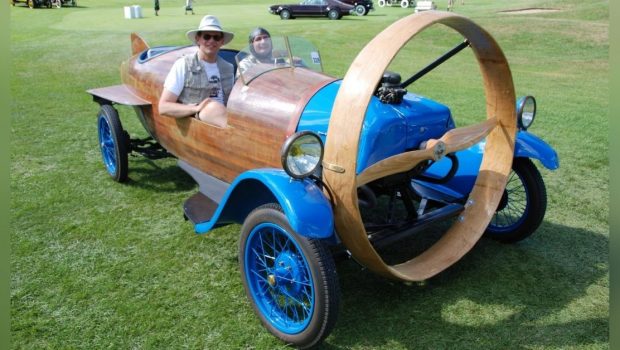They say that necessity is the mother of invention and, throughout history, there is evidence to prove it. Most recently, without the need to try and save the world from the Covid outbreak, the world's best scientists wouldn't have pooled together to create a vaccine.
Other inventions that were born from necessity include the electric light, telephone, and, of course, the automobile. There have been tons of innovations in the automotive industry alone, and before we settled on a standard design, some of the cars of the past were a little eccentric.
Take the Helicron, which is a 1930s open-wheel classic car that uses a propeller to get it moving. A huge slice of inspiration for the Helicron came from airplane technology of the time, but just taking one look at this car tells you why it didn't take off.
Let's look at the Helicron automobile, which used airplane technology for the road.
How Does The Helicron Work?
This odd-looking vehicle looks like a cross between a biplane from the First World War and a car. In truth, it's not far from how the Helicron works. This car was built in the 1930s to use a giant front-mounted propeller just like a biplane.
The chassis was built by renowned French engineer Lucien Rosengart. However, its orientation was backward. This means that the steering wheel of the Helicron turns the rear wheels as opposed to the front. Think of driving a forklift truck but with a blender strapped to the front.
Instead of using an engine to send power to the wheels, the Helicron uses its propeller as the main thrust. This means there is no throttle pedal. Instead, there is a lever that increases the RPM of the propeller when you pull it down, and if you pull it up, the engine stops spinning entirely.
The lever can be freely positioned, which means the RPM responds to where it is set. This lever was placed beside the steering wheel to allow the driver, or pilot, to have the controls at their fingertips.
There is also an emergency brake beside the steering wheel and some brake pedals that you would expect to find in a regular automobile.
Resurrecting The Helicron After A Barn Find
With the plans to put the Helicron into action scrapped in the 1930s, this single model was left abandoned in a barn. It would lie under the covers for almost 70 years until it was discovered in 2000. When discovered, the car was sent to be restored. It had long been forgotten, but once it found its way into a shop in 2000, engineers tried their best to restore it to its former glory.
Much of the Helicron's original parts had rusted or rotted, but they were replaced with like-for-like parts. The original wood frame had to be sandblasted and treated to make it shine once more, while the interior was reupholstered and the gearing rebuilt. While many of the original component parts were found and used in its restoration, the original engine could not.
The Helicron: Vehicle Specs
The restored Helicron may have been missing its original engine, but a Citroen GS 4-cylinder engine was installed in its place. This new engine gave the Helicron's engine enough power to propel it to 75 MPH.
Despite this new engine, the horsepower and torque produced by it are unknown. As the Helicron is a relatively simple build, it only weighs 454 KG. There is no transmission at all in the Helicron, and the engine's output relied solely on the throttle.
Was It Worth Restoring The Helicron?
https://www.youtube.com/watch?v=oYfPIPJF1U0
While it's certainly a unique car, there aren't many positives about the Helicron. There is an immediate danger to life for anyone who manages to get in the way of the propeller blades. Of course, most people avoid oncoming cars at all costs, but the same can't be said for animals.
Any unfortunate birds crossing your path may end up splattered all over the inside of the Helicron. This was proven by a test drive completed by Jason Torchinsky of Jalopnik in 2016. The test driver threw some sausages into the propellers, and they covered both the car and Torchinsky.
Whoever is driving the Helicron must also contend with the practically deafening noise from the front of the car. Those propeller blades spin pretty quickly, and the driver has no chance of listening to their tunes while in control of the Helicron.
Then there is the issue of speed. Propellers work perfectly well when the vehicle they are attached to isn't in contact with something solid, like the road. The Helicron doesn't like to get anywhere fast, which only increases the time its drivers have to spend losing their hearing.
Sometimes it goes so slow you need to get out and give it a little push, so it catches the wind. While testing for Jalopnik, Torchinsky commented that no matter what speed you are doing in the Helicron it always feels unsafe.
However, the car reviewer did admit that as a driving experience, he had a lot of fun behind the unusual wheel of the Helicron. Despite the obvious dangers and drawbacks, after the Helicron was fully restored in 2000, the French safety inspectors passed the vehicle and deemed it safe for road use.
About The Author








Gloss